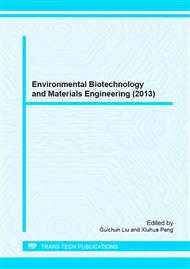[1]
Chuan Chen, Aijie Wang, Nanqi Ren, et al. Enhancing denitrifying sulfide removal with functional strains under micro-aerobic condition. Process Biochemistry. 45(2010): 1007-1010.
DOI: 10.1016/j.procbio.2010.02.013
Google Scholar
[2]
R. -M. Wang, Y. Wang, G. -P. Ma, et al. Efficiency of porous burnt-coke carrier on treatment of potato starch wastewater with an anaerobic–aerobic bioreactor, Chemical Engineering Journal. 148 (2009): 35-40.
DOI: 10.1016/j.cej.2008.07.028
Google Scholar
[3]
C.B. Miguez, C.F. Shen, D. Bourque, S.R. Guiot, D. Grouleau, Monitoring methanotrophic bacteria in hybrid anaerobic–aerobic reactors with PCR and a catabolic gene probe, Applied and Environmental Microbiology. 5(1996): 381-388.
DOI: 10.1128/aem.65.2.381-388.1999
Google Scholar
[4]
B. Tartakovsky,A. Michotte, J.C.A. Cadieux, P.C.K. Lau, J. Hawari, S.R. Guiot, Degradation of Aroclor 1242 in a single-stage coupled anaerobic/aerobic bioreactor, Water Research. 35(2001): 4323-4330.
DOI: 10.1016/s0043-1354(01)00175-0
Google Scholar
[5]
Li B, Sun Y L, Li Yu-ying. Pretreatment of coking wastewater using anaerobic sequencing batch reactor (ASBR). J Zhejiang Univ SCI. 6B (11)( 2005): 1115-1123.
DOI: 10.1631/jzus.2005.b1115
Google Scholar
[6]
State environmental protection administration of china. Water and wastewater monitoring and analytical methods. Beijing: China Environmental Science Press, (2004).
Google Scholar
[7]
APHA. Standard Methods for Examination of Water and Wastewater, 20th ed. American Public Health Association, American Water Works Association, Water Environment Federation, Washington, DC, (1998).
DOI: 10.1002/j.1551-8833.1932.tb18153.x
Google Scholar
[8]
Xiaoxue Wei, Ziyang Zhang, Qinglan Fan et al. The effect of treatment stages on the coking wastewater hazardous compounds and their toxicity. Journal of Hazardous Materials. 239-240 (2012): 135-141.
DOI: 10.1016/j.jhazmat.2012.08.042
Google Scholar
[9]
Kim Y.M., Park, D., Lee, D.S., et al. Inhibitory effects of toxic compounds on nitrification process for cokes wastewater treatment. J. Hazard. Master. 152(2008): 915-921.
DOI: 10.1016/j.jhazmat.2007.07.065
Google Scholar
[10]
Vázquez, I., Rodríguez, J., Maranon, E., et al. Simultaneous removal of phenol, ammonium and thiocyanate from coke wastewater by aerobic biodegradation. J. Hazard. Master. 137(2006): 1773-1780.
DOI: 10.1016/j.jhazmat.2006.05.018
Google Scholar
[11]
Kumar MS, Vaidya AN, Shivaraman N, et al. Biotreatment of oil-bearing coke-oven wastewater in fixed-film reactor: a viable alternative to activatd sludge process. Environ Eng. Sci. 17(2000): 221-226.
DOI: 10.1089/10928750050137561
Google Scholar


